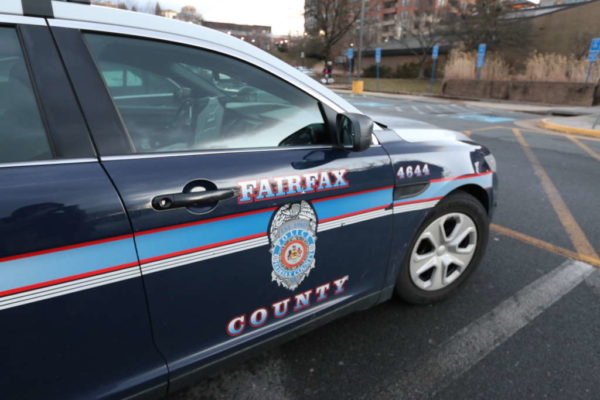The Fairfax County Police Department has concluded for a second time that allegations of racial profiling by one of its officers during a 2019 incident in Herndon were unfounded.
The Fairfax County Board of Supervisors directed police to revisit the case in question in January after the county’s Police Civilian Review Panel recommended an additional review in its first-ever challenge of police findings.
According to a June 1 FCPD memo obtained by Reston Now, the second review — this time under a new police chief — found no evidence that a police officer who followed and questioned a Black driver was motivated by racial bias.
“I have reviewed the supplemental investigative findings and concur that no new evidence was revealed to support the allegation of bias-based policing,” Fairfax County Police Chief Kevin Davis said in the memo.
Davis took over as police chief on May 3 amid criticism of his past work in Baltimore and Prince George’s County. In the initial months of his tenure, he has emphasized his willingness to introduce reforms, including revisions to the department’s vehicle pursuit policy and the addition of a data director.
For its follow-up investigation of the Herndon incident, Fairfax County police asked eight employees in the Reston District Station’s Criminal Investigations Section the following question:
“Do you have any direct or indirect knowledge which would indicate [employee name] has engaged or is engaging in behavior that was or is motivated by bias toward a victim’s race, religious conviction, ethnic/national origin, disability, and/or sexual orientation?”
Police said no one indicated there was any evidence of bias exhibited by the detective.
Davis also suggested options for reviewing the case were limited, noting that FCPD started collecting data on officers’ interactions with civilians last October that it wasn’t measuring at the time of this particular incident.
The change aligns with new state requirements for police data collection that took effect on July 1.
“Due to recent updates in Virginia legislation, the Virginia Community Policing Act, the Department has updated our current record management system to capture additional details pertaining to the circumstances of community contacts,” the FCPD said in a statement. “The further details will allow our Department to better understand the contacts we have within our community.”
In his memo, Davis wrote that the department has “further enhanced our transparency by creating a Police Data Sharing Dashboard” that allows people to search information related to warnings, citations, and arrests.
The civilian review panel began reviewing the Herndon incident on May 23, 2019, when it got a citizen’s complaint about an officer who followed him into the parking lot of his apartment complex and repeatedly questioned whether he lived there. Read More
A police use-of-force study commissioned by Fairfax County revealed that officers use force too often and more than should be expected against both Black and white civilians.
Findings and recommendations of the study conducted by researchers from the University of Texas at San Antonio were presented at the county’s Board of Supervisors public safety committee meeting yesterday (June 29).
The study dove into the 1,360 use-of-force cases involving the Fairfax County Police Department over a three-year period from January 2016 to December 2018.
About 42% of cases were directed at those who are Black, 38% to those who are white. Hispanic and Asian civilians comprised 16% and 3% of such cases, respectively.
Additionally, Black civilians were 1.8 times more likely to have a weapon, such as a taser or firearm, pointed at them by police.
Some of the findings surprised the researchers. For example, there was a higher level of use of force cases directed at those who are white than perhaps expected, and generally, police used force against Hispanic civilians less frequently than they predicted..
“It’s a little bit unusual to findings like that, in my experience,” said University of Texas professor Michael R. Smith, one of the researchers presenting the study. “But those are what they were here in Fairfax County.”
For Black people, who make up about 10.6% of Fairfax County’s population, force rates did exceed proportional rates in most categories — disparities that Smith noted were expected.
Some of the disparities can be tracked to specific district stations as well.
Force used against Black civilians happened at higher rates in the Mount Vernon District as well as in Franconia, McLean, and West Springfield.
Also, worth noting is that while use of force rates against Asian civilians, who now compose 20% of the county’s population, was overall lower across the county than other racial groups, it exceeded proportional benchmarks in Reston, Fair Oaks, West Springfield, and Mount Vernon.
Men are also much more likely to have more severe force used against them than women, which the researchers said was not uncommon.
A data point that roiled some county board members was if pointing a weapon (firearm or taser) constituted a Level 1 or more severe Level 3 use of force.
For the purposes of the study and after consulting with FCPD, researchers admitted they knocked down the severity of pointing a weapon, which altered the data.
“After some preliminary discussions with senior leadership of the police department, we re-coded the pointing of a weapon — typically a taser or a firearm — to a level one,” Smith said. “This showed…the disparity in force against African-Americans was largely [having to do with] the pointing of the weapon.”
The data revealed that Black civilians were close to nearly two times more likely to have a weapon pointed at them than white civilians.
“These coding decisions matter. It’s a conceptual question,” said Smith. “Police departments around the country and their communities are wrestling with this right now…How serious is it to point a weapon at someone?” Read More
Police Investigate Offensive KKK Flyers — Bigotry-filled flyers aimed at the Fairfax County School Board were found earlier this week in the Springfield and Sully Districts, apparently distributed by the Loyal White Knights of the Ku Klux Klan. School board members and local leaders, including Fairfax County Board of Supervisors Chairman Jeff McKay and the president of the county’s NAACP chapter, denounced the flyers, which are under investigation by county police and the FBI. [Patch]
Carjacking Reported in Reston Town Center — A man with a gun told a person in the passenger seat of a 2004 Toyota Corolla to get out and drove away in the car. The incident occurred at 5:25 a.m. on June 12 in the 1800 block of Presidents Street. The victim was not injured, police say. [FCPD]
A History of Slavery in Herndon — Ahead of Juneteenth, which commemorates the abolition of slavery in the U.S., Herndon Historical Society member Barbara Glakas delves into the lives of some past Herndon residents known to have held slaves. She notes that information about individual enslaved people is difficult to find due to the limited availability of written records. [Patch]
Reston Station Releases Showcase Video — Reston Station released a video yesterday (Thursday) showcasing the vision for the mixed-use development by the Wiehle-Reston East Metro station. The video breaks the area up into the Metro Plaza District, the Reston Row District that will be anchored by a JW Marriott hotel, the health-oriented West District, and the office-heavy Commerce District. [Reston Station/Facebook]
D.C. Area Sees More Hunger During Pandemic — “More families in Virginia and Maryland, and significantly more Latino families, were pushed into food insecurity during the COVID-19 pandemic, according to a new report on hunger in the D.C. area, which a nonprofit official called a ‘dramatic shift in the face of hunger.'” [WTOP]
Photo via vantagehill/Flickr
Man Charged in Reston Condo Murder — 24-year-old Alexander Jahelka has been charged with second-degree murder after police found his father, 66-year-old Kenneth Jahelka, suffering from stab wounds in a condominium in the 11800 block of Shire Court on Saturday (May 22). This is the eighth homicide that Fairfax County has seen this year and the third in Reston. [FCPD]
Dead Body Found on Herndon Golf Course — “Detectives from the Herndon Police Department believe that man whose body’s was found Friday morning [May 21] at Herndon Centennial Golf Course had died accidentally, according to Lisa Herndon, HPD spokeswoman…A golf course employee found the body in a pond on the property and contacted police, according to Herndon. HPD identified the body as that of an adult male.” [Patch]
BLM Banner Stolen from Reston Church Again — Unitarian Universalist Church members noticed that the church’s Black Lives Matter banner was missing again on Thursday (May 20). Installed in September, this was the church’s second BLM banner after one raised last June in response to the racial justice protests spurred by George Floyd’s murder was also stolen. [Patch]
Reston Association Reviewing Updated COVID-19 Guidelines — “Until the review is completed, RA will continue to require the use of masks, a pool reservation sign-up system and social distancing at all RA facilities, including pools. RA will inform members of any changes in operating procedures due to the governor’s order as soon as possible. The association’s first priority is to ensure the safety of our employees and members.” [RA News]
Reston Singer Releases New Single — “Emerging singer-songwriter Amanda Cunningham of Reston shares her struggle with personal accountability, power when forming close friendships, and self-esteem in her newest single, “Pattern” (2021). Originally a self-described pop/rhythm and blues [R&B] singer, Cunningham recently admitted her voice and lyrics are turning more country.” [The Connection]
Photo via vantagehill/Flickr
(Updated at 4 p.m.) Starting July 1, adults 21 and older in Virginia can legally possess up to one ounce of marijuana.
Ahead of that date, local police departments say they are preparing their officers, while advocates say the bill needs serious retooling to keep kids out of the juvenile justice system and help reverse the harm done to Black and brown communities after decades of unequal enforcement.
“We still have time to fix many of these things,” Chelsea Higgs Wise, executive director of the racial justice and cannabis advocacy group Marijuana Justice, said. “Between now and then, we have elections. We have to talk to people about how they’re going to take this legalization forward while centering equity. This is not over.”
The Virginia General Assembly passed a law earlier this month accelerating the legalization of weed from July 2024 to this coming summer. The law will be reenacted in 2024, when recreational, commercial sales are legalized.
Through June 30, the possession of less than one ounce of cannabis will remain “decriminalized” — that is, it is penalized with a fine, but the incident does not show up on a person’s criminal record.
The new law legalizing cannibis essentially permits those 21 and older to use marijuana inside their homes, and possibly in their backyards; grow up to four plants; and possess up to one ounce of cannabis. The plant must be in a manufacturer’s container for someone to drive with it in the car legally.
Giving cannabis to someone underage is considered a felony, while students younger than 21 who are found in possession of the plant on school grounds would be charged with a misdemeanor. A clause requires court-ordered drug treatment services for individuals 20 and under found with the plant.
People in jail for marijuana-related crimes will remain there, Virginia Mercury reports.
Here are the top areas of interest and concern for police officers, people in the criminal justice system and advocates.
Marijuana-related arrests
Although marijuana-related arrests have been trending down recently, Falls Church City Police Chief Mary Gavin says that one potential consequence of marijuana legalization is more people driving while stoned.
“There are going to be obviously growing pains,” Gavin said. “My biggest concern, in terms of public safety, is the possible increase of driving under the influence.”
According to data provided to Tysons Reporter by the police departments, cannabis arrests appear to be trending down slightly in both Fairfax County and Falls Church City. A chart supplied by Fairfax County Police Department shows arrest rates peaking in 2018 before dropping off dramatically in 2020.
The Falls Church City Police Department reported a similar pattern. It made 61 and 63 arrests in 2018 and 2019, respectively, followed by 17 arrests in 2020 and none so far this year.
Herndon Police Department spokesperson Lisa Herndon said the town had about 125 marijuana-related arrests from Jan. 1, 2018 to Dec. 13, 2020.
Gavin attributed the recent drop-off in arrests to a combination of the COVID-19 pandemic and a policy change introduced by Fairfax County Commonwealth’s Attorney Steve Descano, who ceased prosecuting simple marijuana possession cases against adults when he took office on Jan. 2, 2020.
Descano told Tysons Reporter, Reston Now’s affiliate site, that he stopped prosecuting marijuana cases because it would be the right approach for community safety and racial equity. His office estimates that more than 1,000 cases have since been dismissed.
“While the opposition to this decision was intense at the time — so much so that we planned to create a bail fund in case our attorneys were held in contempt of court and jailed — I am pleased that other jurisdictions followed suit and marijuana has now been legalized across the Commonwealth,” Descano said. Read More

This is an opinion column by Del. Ken Plum (D), who represents Reston in Virginia’s House of Delegates. It does not reflect the opinion of Reston Now.
Virginia made history last week: The Governor of Virginia Ralph Northam signed the bill that made Virginia the first state in the south and the 23rd state in the nation to end the death penalty! I made the nearly four-hour trip to the Greenville Correctional Center in Jarrett where the “death chamber” is located to be at this momentous occasion when another of my legislative goals was realized.
While some have justified the death penalty as an appropriate “eye for an eye” punishment and a deterrent for other crimes, the history of the death penalty is much more complex. Virginia executed more people than any other state having executed 1,390 people over its 413 years. Its uneven application among the states and within the state itself is astounding. Virginia executed 94 women over its history, twice as many as the state with the next most executions of women. Of those, 78 were Black, 11 were White and five were of unknown race. Sixteen children below the age of 18 were executed including a slave girl about 12 years old who was hung in 1825. In 2005 the United States Supreme Court declared that the execution of those under the age of 18 at the time of their crime was cruel and unusual punishment and hence unconstitutional. It followed an earlier decision in a Virginia case that found that executing an intellectually disabled person as the state was poised to do was unconstitutional.
Until the first electrocution in 1908, executions in Virginia were carried out by hanging making them not unlike the lynchings of Blacks that had occurred throughout the South. From 1900 until the U.S. Supreme Court declared the death penalty unconstitutional in 1977 for crimes in which no one was killed, Virginia executed 73 Black defendants for rape, or attempted or armed robbery that did not result in death, while no White defendants were executed for those crimes.
Other numbers show how the death penalty was more an act of White supremacy than for public safety. Between 1900 and 1999, there were 377 executions and of those 296 were Black persons and 79 White persons. For murder there were 304 executions, 223 Black and 79 White persons. For rape 48 Black persons and for attempted rape 20 Black persons executed, and in both instances no White persons were executed.
One of the most unbelievable stories in the history of the death penalty in Virginia was the execution of five Black defendants on February 2, 1951, and the execution of two more Black men on February 5, 1951, accused of raping a White woman. An all-White jury meted out the punishment after trials that lasted one day per defendant.
We cannot rewrite this dark chapter of Virginia’s history, but we must learn from it. Too many laws in the past were written to maintain White supremacy rather than protect the public equally. The General Assembly has made major strides at ridding the Code of Jim Crow laws. We can see the repeal of the death penalty as a major step in moving Virginia forward as a more just state.
County Issues Statement on Georgia Shootings — Fairfax County Board of Supervisors Chairman Jeff McKay says his thoughts are with the families and friends who lost loved ones in Tuesday’s shootings in George. He called the attack and the rise in violence against Asian Americans “horrifying, deeply disturbing, and unacceptable.” [FCPD]
Steward of Reston-based Engineering Firm Dies — “Stephen D. Bechtel Jr., who led his family’s engineering and construction firm for three decades, expanding an already sprawling operation into an international behemoth with projects including the Channel Tunnel linking Britain and France and Jubail Industrial City in Saudi Arabia, died March 15 at his home in San Francisco. He was 95. Bechtel announced his death but did not cite a cause.” [The Washington Post]
Northam Restores Voting Rights for Ex-Convicts — “Virginia Gov. Ralph Northam has cleared the path to the ballot for tens of thousands of ex-felons by officially reinstating their civil rights.” [WTOP]
Registration for Reston Association Tennis Resumes — RA has officially opened up registration for tennis lessons for kids, teens and adults. New sessions will start soon. [RA]
 This is an opinion column by Del. Ken Plum (D), who represents Reston in Virginia’s House of Delegates. It does not reflect the opinion of Reston Now.
This is an opinion column by Del. Ken Plum (D), who represents Reston in Virginia’s House of Delegates. It does not reflect the opinion of Reston Now.
One of the meaningful traditions that has evolved in the Virginia House of Delegates over the last couple of decades has been the celebration of Black History Month by having a speech each day on the House floor about famous Black persons and their struggles and accomplishments in the Commonwealth. According to History magazine, Black History Month is an annual celebration of achievements by African Americans and a time for recognizing their central role in U.S. history. Also known as African American History Month, the event grew out of “Negro History Week,” the brainchild of noted historian Carter G. Woodson and other prominent African Americans. Since 1976 the month of February has been designated as Black History Month and is celebrated around the world, including in Canada and the United Kingdom.
Virginia has a unique role in Black history. The first enslaved Blacks arrived in Virginia in 1619, and the labors of these persons were central to the growth of the Virginia colony and then state. It was Black laborers who built the grand plantations’ homes and the institutions of higher education while themselves living in meager housing and refused entrance into public schools and colleges. It was Black slave labor that built the early Virginia tobacco economy while being denied all but the most limited income. Black persons supported the lifestyle of the most prominent Virginia families with no public recognition of their accomplishments. As significant as were Jefferson’s words that “all men are created equal” in the Declaration of Independence, they did not apply to the slaves in his household nor to the Constitution that counted them as 3/5ths of a person.
The Emancipation Proclamation, the outcome of the Civil War and the passage of the Thirteenth Amendment did not result in equality under the law for Black citizens. Under federal Reconstruction government about one hundred Black citizens were elected to public office between 1869 and 1890 including a Black congressman, but a swift reaction by conservative whites led to Jim Crow laws and voting laws that quickly curtailed the power of Black voters. The 1902 Virginia Constitution that included a literacy test and poll tax for voting limited the number of Black voters to such a degree that they did not regain their numbers at the turn of the century until the 1990s.
The recent history of voting in Virginia offers reasons to celebrate. There are more Black members of the Virginia General Assembly today than at any time since Reconstruction. There are two Black congressmen from Virginia. The Lieutenant Governor, the President of the Virginia Senate, and the majority leader of the House of Delegates are Black. The General Assembly has made historic strides in repealing Jim Crow laws, expanding voter participation and reforming criminal justice laws and practices that discriminated against persons of color. Virginia was the first state to have a Black governor, and for the nominations to run this fall there are at least two Black women and one Black man running for governor, two or more Black men running for lieutenant governor and at least one Black man running for the attorney general nomination. There are ample reasons to be celebrating Black history in Virginia this month and throughout the year.
For the first time since it formed in 2016, the county’s Civilian Review Panel has cited its disagreement with the Fairfax County Police Department’s investigation of racial bias allegations that happened in Herndon in 2019.
Because six of the nine-member panel disagree with the findings of FCPD’s investigation, the Fairfax County Board of Supervisors directed the police department to address the panel’s requests for the next steps. The matter was discussed at a board meeting on Tuesday.
The panel disputed FCPD’s findings that an interaction in 2019 between a police officer from the Reston District Station and an African American man in Herndon was motivated by racial bias.
The man said he felt that he had been targeted and suspected of trespassing “for no reason at all.”
According to the investigation file, the officer began following the man’s car when he turned at a red light in Herndon and stared at the officer. When he ran the car’s license plate and it matched with a woman in Virginia Beach — what he knew to be “a source city for illegal substances” in Fairfax County — his suspicions grew and he followed the man into his apartment complex in Herndon.
The officer approached the man and asked him for his identification, where he lived, and other identifying information. In a complaint submitted to the county, the man said he was shaken by the encounter and was “extremely frightened and nervous.” He recorded the encounter on his cell phone.
According to the report, the officer stayed in the parking lot for a few more minutes after he verified the man’s identity and ran the license plate again.
The man, whose name was not released, said he felt the incident was racially motivated because the officer believed he did not live in the apartment complex and stood in a manner that hindered his ability to get out of his car. No use of force was exercised in the incident.
In official comments to the panel, FCPD Chief Edwin Roessler said that while the office had a series of “poor, cascading assumptions and judgments that were wrongly based on his training,” there is no evidence that race was a factor in the incident.
He acknowledged that FCPD said the encounter indicates that there are some elements that need to be “train[ed]-away.”
“We can’t just keep going to proactive patrol training,’ Roessler told the civilian panel during the course of its investigation. “I pray that you are understanding that as your Chief I don’t want this to happen to anyone else.”
However, the panel determined that FCPD’s internal review did not thoroughly investigate allegations of racial bias and racial profiling. The panel also concurred with the chief that the officer was not professional.
“The investigative record was virtually silent as to why the officer decided to follow the complainant in the first place and panel members questioned whether a similarly situated white driver would ever have been followed in such a manner,” according to the panel report.
But when the panel did not receive additional information about the investigation last year, the panel voted to advise the board that the investigation was incomplete and needed follow-up interviews with the officer’s coworkers and deeper data analysis.
The panel also found that FCPD lacks objective criteria to evaluate racial bias or profiling incidents. It encouraged the police department to include all community contacts, stops searches and arrests into a data management system. Other recommendations are listed below.
Data analysis of an officer’s community contacts, stops, searches and arrests should be compared and contrasted with comparable data from the district station where the incident occurred and the county as a whole. The data analysis should also take into account the racial and ethnic composition of each district as compared to the county overall.
For the purposes of investigations into allegations of bias or profiling, data analysis of the officer’s community contacts, stops, searches and arrests should cover a period of 3-5 years, or if the officer has less tenure, for the duration of his service in the FCPD. If during the prescribed time period the officer has worked in different districts within the county, the review and analysis of the officer’s community contacts, stops, searches and arrests should not be limited to the district where the officer is assigned at the moment, but rather should include all such encounters in every county district where the officer served during the time period.
Like the efforts the FCPD has undertaken to analyze and identify use of force incidents, the FCPD should consider creating an early warning system to alert commanders as to whether an officer’s community contacts, stops, searches or arrests are excessive and disproportionate for a particular race or ethnic group.
The FCPD should retain an independent expert on implicit bias to examine all law enforcement policies, practices and training for the purpose of recommending evidence-based strategies to mitigate the impact of implicit bias on policing.
Officers should receive implicit bias training on an annual basis.
The county’s board voted to direct Roessler to take further action on the panel’s requests.
The Civilian Review Panel reviews FCPD investigations containing “allegations of abuse of authority or serious misconduct to ensure accuracy, completeness, thoroughness, objectivity, and impartiality,“ according to the county’s website.
Photo via FCPD
 This is an opinion column by Del. Ken Plum (D), who represents Reston in Virginia’s House of Delegates. It does not reflect the opinion of Reston Now.
This is an opinion column by Del. Ken Plum (D), who represents Reston in Virginia’s House of Delegates. It does not reflect the opinion of Reston Now.
Last Sunday evening Confederate General Robert E. Lee lost his position of representing the Commonwealth as part of the Statuary Hall Collection at the United States Capitol. A copy of a statue of General Lee by sculptor Edward Valentine had been standing in the Capitol since 1909 most recently in the Crypt where a statue representing each of the thirteen original states stood. General Lee’s statue was carted off just as statues of him have been taken down across the state including the huge equestrian statue of him that will be taken down from Monument Avenue in Richmond as soon as lawsuits about it are resolved.
The other statue representing Virginia in the Capitol Statuary Collection is a copy of Houdon’s statue that stands in the Rotunda of the State Capitol in Richmond of the Father of Our Country George Washington. It was Washington’s strong leadership and the time-honored precedents he set that helped the new nation to get started. Lee on the other hand had led an insurrection that attempted to break away from the nation and establish the Confederate States as a separate country that allowed slavery of human beings!
Who else could represent Virginia as the second statue allowed by each state in the Statuary Collection? The Governor appointed a commission to answer that question. After their public hearings and deliberations, the commission concluded that the appropriate person should be Barbara Johns. For too long a time many Virginians have not known of the heroic acts that Barbara Johns did to help set the course for recent history in Virginia. Her statue is already on the Virginia Capital grounds in the Virginia Civil Rights Memorial recognizing her leadership in bringing about changes in the unequal ways that white and black schools were funded in Virginia.
The Supreme Court case Brown v Board of Education in 1954 that desegregated public schools included a Virginia case that came about as a result of a boycott of Prince Edward County Schools led by 16-year-old Barbara Johns. White children in Prince Edward County went to school in a new brick building while Black children went to school in a tar paper shanty with limited heating. NAACP lawyers Oliver Hill and Spotswood Robinson took her grievance all the way to the Supreme Court and won!
Barbara Johns will join Rosa Parks who was the first Black woman to have a full-size statue in the U.S. Capitol. As Virginians we can be proud to show our children and grandchildren the statue of Barbara Johns representing us and explain to them the important role she played in standing up to injustices and bringing about significant civil rights changes in our state.
The Fairfax County Board of Supervisors met with the Fairfax County History Commission on Tuesday to discuss Confederate associated street and place names across the county.
This project began after the June 23 and July 7 board meetings, where the commission set out to create an inventory of Confederate places and structures within the county following the Black Lives Matter movement and the death of George Floyd.
After identifying more than 26,000 streets and places in a report, the board narrowed the focus list to 650 well-known Confederate Officers and locally-known Confederates. After researching those names, the Commission found 150 assets to have confirmed Confederate associated names, according to the presentation by Anne Stuntz, the chairwoman of the History Commission.
Names identified in the Hunter Mill District include the Lee Manor Subdivision, Fort Lee Street, Mosby’s Landing Condominium Complex, and Wade Hampton Drive.
The commission recommended that the Board of Supervisors create a public dialogue regarding the issue through public meetings and community gatherings, and follow those discussions with deliberation and definitive action on the Confederate names. The Commission also recommended that all project research is archived in the Virginia Room in the City of Fairfax Regional Library because of the extensive project research.
Tom Biesiadney, director of Fairfax County’s Department of Transportation, discussed the process of petitioning the Commonwealth Transportation Board to change the name of Lee Highway and Lee-Jackson Memorial Highway. The commonwealth says there needs to be public input, as well as a request from the Board of Supervisors to change the name.
The Commission created a 2021 initiative in response to the Confederate listing, aiming to develop an inventory of research materials on African American communities in Fairfax County in collaboration with African American organizations including churches, social and community groups.
The Commission is using a model identified by the city of Alexandria. Additionally, this summer, the City of Fairfax developed a framework process for identifying Confederate-associated names throughout this city and is partnering with George Mason University to provide community learning sessions on the issue, according to the presentation.
The board shared their appreciation for the extensive and intricate research by the History Commission. Additionally, Board members mostly agreed that the first priority should be the renaming of the highways, and from there, move forward with a community. process for renaming the secondary and neighborhood streets.
One concern came from Lee District Supervisor Rodney Lusk regarding the history of the district’s name.
“I was hoping that there’d be something more definitive about Lee District, in terms of where its name originated, but it appears that we still have the same set of ambiguity,” said Lusk. “We will have to have a community conversation about this name of this district.”
Additionally, Springfield District Supervisor Pat Herrity expressed concern in rushing into the name change process in the midst of the pandemic and emphasized the need for “robust community participation” before moving forward.
Image via the Fairfax County History Commission
 This is an opinion column by Del. Ken Plum (D), who represents Reston in Virginia’s House of Delegates. It does not reflect the opinion of Reston Now.
This is an opinion column by Del. Ken Plum (D), who represents Reston in Virginia’s House of Delegates. It does not reflect the opinion of Reston Now.
Communications experts advise that a message needs to short and punchy to convey its intended meaning in a short period of time. Short and sweet can lead however to confusion, mixed meaning and unintended consequences.
Virginians have realized the fallout from simple, bumper-strip-sized messages in the past. “End parole” as a campaign slogan helped former Governor George Allen overcome a 20-point polling difference to be elected governor. For some people the slogan meant less crime and safer streets, but it also filled Virginia’s prisons to over-flowing shifting huge sums of money from other programs to the Department of Corrections. More people were incarcerated and for longer lengths of time, but the crime rate stayed essentially the same. The campaign slogan “End the Car Tax” got Jim Gilmore elected governor, but the resulting policy costs Virginia schools nearly a billion dollars every year even until today.
I am not particularly good at campaign slogans, but I am fearful that the current “Defund the Police” slogan in response to the real problems in policing throughout the country may inhibit progress towards reform. The number of people who want to literally take all funding from the police is small, but the use of a simplistic phrase to describe the reform movement may turn off many moderates and completely scare away conservatives. There has to be a better way to describe the desired outcomes that reflects the complexities of the problem.
Policing desperately needs reform at all levels of government. The misuse of police power and tactics by the federal government in Portland is frightening, and the Congress must take steps to reign in the administration politicizing the use of police powers. At the state level Virginia needs to increase–not defund–its funding of state police to ensure that its pay structure will attract the best trained and most professional persons to its ranks. It needs to be able to fill its open slots to reduce overtime and stress on its current force.
At the same time the Virginia General Assembly needs in its special session this month to enact the reforms proposed by the Legislative Black Caucus including eliminating the use of choke holds, using body cameras, and enhancing training.
The same reforms need to be applied to police at the county, city and town levels including sheriff departments in Virginia. The responsibilities that have befallen the police in the area of mental health need to be assumed more by personnel in the departments responsible for and skilled in this area of concern.
The public demands and legislators will ensure that the public is safe. At the same time we must demand and put into existence a system free of discrimination and inappropriate use of force. That means we need to redefine our expectations of policing and reimagine the role of public safety officers in our society. We must be willing to spend dollars appropriately to accomplish those objectives. It is over-simplifying a complex issue to suggest that we can “defund the police.”
File photo
Fairfax County Public Schools’ superintendent said he is committed to tackling racism in the public school system during a town hall last night.
The Fairfax County NAACP met with FCPS Superintendent Scott Brabrand to talk about how to address systemic racism going into the 2020-2021 school year.
The discussion between Sujatha Hampton, the Fairfax County NAACP’s education chair, and Brabrand, along with several other guests, focused on a list of priorities from Fairfax County NAACP to address equity.
Brabrand repeated throughout the town hall that he was ready to be held accountable for making change. “We need to be more comfortable feeling uncomfortable,” Brabrand said at the end of the meeting.
The town hall began with a discussion on COVID-19 and the status of reopening schools. On July 21, Brabrand announced that schools would be opening virtually on Sept. 8. Hampton made it clear that it will be essential to address the inequities that online learning presents in minority communities.
What would an anti-racist school system look like and how can FCPS strive for that? Hampton had several proposals.
One would address the scope of the chief equity officer position within the county, with Hampton noting the importance of hiring someone with “anti-racist” policies versus a traditional hire for the position.
Hampton’s proposed job description included conveying “transformational leadership” and having “successful experience as a change agent.”
“Anti-racism is a fairly new thing for systems to be considering,” said Hampton when emphasizing the importance of radical change with leadership.
Another priority is creating an anti-racist curriculum. FCPS Social Studies Coordinator Colleen Eddy said that they are already in the process of auditing the existing curriculum.
A major topic of discussion was the disproportionate discipline statistics in the county’s schools. Hampton presented a series of data points showcasing the high number of Black students receiving referrals for “disruptive behavior” versus their peers. FCPS Deputy Superintendent Frances Ivey agreed that it’s time to reinforce positive behavior rather than disciplining students.
Hampton also discussed the lack of Black teachers and principles within the school system and emphasized the importance of creating a data-driven plan to hire more Black teachers in a transparent way. She said the culture of a school stems from a principal, and it is “criminal” to give kids a racist principal.
“I want everyone to remember that these are actual children’s lives,” Hampton said.
Photo via Sam Balye/Unsplash
Fairfax County NAACP announced a new virtual town hall to discuss system racism in public schools with Fairfax County Public Schools Superintendent Scott Brabrand.
Brabrand was originally going to co-host a town hall on the topic with Fairfax NAACP on July 21. He dropped out of the event, which took place the same night the county’s school board reconsidered reopening plans for schools.
Fairfax NAACP pivoted and used the town hall on July 21 to unveil the organization’s priorities for combatting racism in schools. Fairfax NAACP President Sean Perryman said during the event that the organization would work to reschedule the discussion with Brabrand.
Now, Brabrand and Fairfax NAACP are scheduled to host a town hall from 6:30-7:30 p.m. on Wednesday, Aug. 5. People can watch the event on Facebook Live.
“One topic that will be discussed is the School-to-Prison Pipeline,” Fairfax NAACP posted on Facebook, sharing a YouTube video by The Root, a Black-oriented online magazine, that explains how the School-to-Prison Pipeline works.
Here’s the event description:
From academic achievement, enrollment at Thomas Jefferson High School for Science and Technology, to the School Resource Officer program and the school-to-prison pipeline, systemic racism effects our children’s lives every day. This will be a civil discourse where we can openly talk about our and our kids’ experiences, ask questions, and talk about what change looks like.
Photo via Sam Balye/Unsplash
Fairfax County NAACP shared nine priorities for tackling racism in the county’s public schools on Tuesday night.
The virtual town hall was originally set to be a two-hour discussion with Superintendent Scott Brabrand, but Brabrand declined and instead attended the school board’s meeting to push for a fully online start to school.
Sujatha Hampton, the chair of Fairfax NAACP’s education committee, presented the nine priorities. “Black kids are regularly asked to swallow their pain,” Hampton said.
The event Tuesday night received more than 1,700 views. Most of the discussion and comments focused on school resource officers (SROs), the Advanced Academic Programs (AAP) and principals’ power.
Advanced Academic Programs
Several commenters claimed that there are “drastic” differences between the general education curriculum and AAP Program. “I support getting rid of the AP program for SO MANY reasons,” one person wrote. “We could do so much more as a school system if we didn’t have it.”
The organization’s president Sean Perryman said that the AAP Program is large, referring to a Washington Post story about students getting into the program through the appeals process.
“There’s a reason for us to look deeply at the AAP Program to see if the juice is worth the squeeze,” Hampton said. “It has so many problems, let’s just take a look at it.”
School Resource Officers
For SROs, Perryman said he wants to have more conversation around the idea of taking officers out of schools, questioning how effective SROs have been in preventing and responding to school shootings. Instead, SROs can increase the school-to-prison pipeline for Black and Latino students, Perryman.
“I know for a lot of people, it gives them heartburn when they think we’re going to take the SROs out of schools because they have this understanding that if a cop is present in the school, my child is safe,” Perryman said.
Especially now that FCPS will start off the school year virtually, Perryman said that state funds that go to SROs can instead get used for therapists — “counselors not cops,” he said.
Principals
Several commenters agreed that principals should take the lead on creating an anti-racist school culture.
Hampton said that principals have “tremendous power” over their schools — “almost like a mini fiefdom” — when deciding disciplinary actions.
Here are the nine priorities:
- protect vulnerable students, faculty and staff most impacted by COVID-19
- add more support for Equity and Cultural Responsiveness Team in schools*
- have the School Board vote on removing SROs from schools*
- make curriculum review committees to scrutinize racial/cultural bias*
- create a plan to hire and improve retention of Black and Latino teachers
- examine AAP’s admission process, goals, etc.
- review demographics and accessibility of abstract math, Honors, AP and IB classes to increase Black and Latino students*
- examine the roles of principals and regional superintendents to ensure effective oversight on equity issues
- review and revise the admission process to Thomas Jefferson High School
- *priorities to be completed by end of the upcoming school year
Perryman said that the organization will work to reschedule the discussion with Brabrand.
People can watch the full video on Facebook Live.
Photo via Sam Balye/Unsplash


